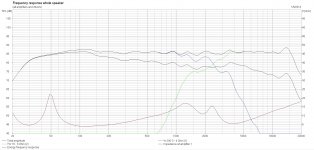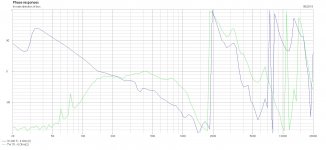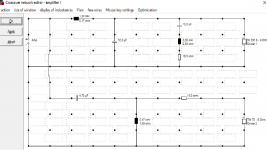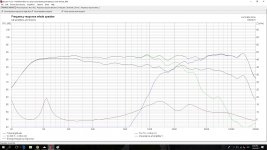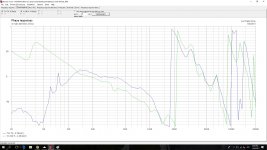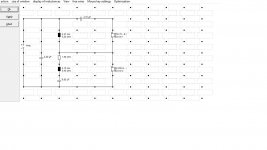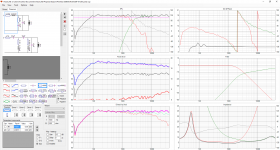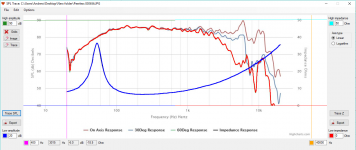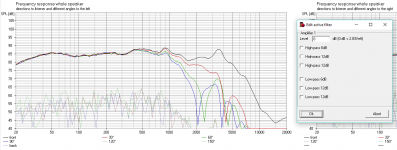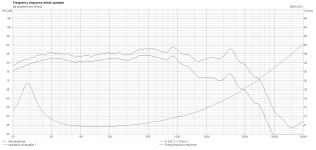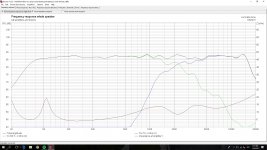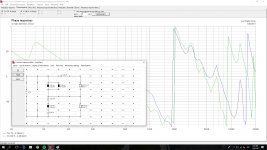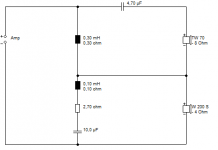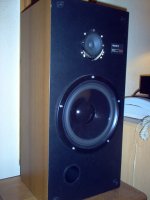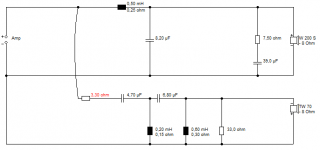Hey guys I have been designing a speaker. I don´t want to call it La Scala clone, because it is not. But it is using same drivers.
Since I´m complete noob in speaker building, I wanted to show my simulations, and maybe you guys can help me out, if there is something completely wrong, or thumbs up, if it looks good.
I´m a bit worried about the phase graph. Not sure how good it looks.
Not sure IF I want to use the tw70. I would like to try Monacor ht-22. But I cant simulate it. IT has a very similar graph to ke25SC, and This also fits my simulation.
Project file in .zip. And a few pictures, who just want a quick look.
Thanks
Since I´m complete noob in speaker building, I wanted to show my simulations, and maybe you guys can help me out, if there is something completely wrong, or thumbs up, if it looks good.
I´m a bit worried about the phase graph. Not sure how good it looks.
Not sure IF I want to use the tw70. I would like to try Monacor ht-22. But I cant simulate it. IT has a very similar graph to ke25SC, and This also fits my simulation.
Project file in .zip. And a few pictures, who just want a quick look.
Thanks
Attachments
It is OK, phase is not ideal but not massively out. I dont recongnise the simulator you are using does it include a offset delay from the tweeter to the woofer. If not phase could be worse in real design.
If you add a resistor to the bass capacitor you might find you can adjust the filter to bring the phase in over a larger part of the crossover. Going third order on the tweeter by adding another cap might allow you to get a better response and suppress the resonant region of the tweeter further.
If you add a resistor to the bass capacitor you might find you can adjust the filter to bring the phase in over a larger part of the crossover. Going third order on the tweeter by adding another cap might allow you to get a better response and suppress the resonant region of the tweeter further.
Thanks. I will try out the simulator. And play a bit more with the crossover.
This is Boxsim, and yes it includes offset of the drivers. If you want to see the whole project, you just have to download boxsim and load my file, that is in .zip folder.
This is Boxsim, and yes it includes offset of the drivers. If you want to see the whole project, you just have to download boxsim and load my file, that is in .zip folder.
It looks like Visaton have pulled BOXSIM from their site, all the info is still there but when you go to the download it takes you to an empty page.
Yep. Seems it is down.
I could not make it better. It was a trade of ofor better phase hiher up tradeoff vs lover phase and frequency response.
But there is a different crossover that I tried, and the phase looks better, not sure if I like the frequency as much, but it looks okey.
I could not make it better. It was a trade of ofor better phase hiher up tradeoff vs lover phase and frequency response.
But there is a different crossover that I tried, and the phase looks better, not sure if I like the frequency as much, but it looks okey.
Attachments
You can, you have to trace the FR and impedance graphs from the published ones and create frd and zma files. Then you can import them into boxsim. You'll have to estimate the voice coil position however.I would like to try Monacor ht-22. But I cant simulate it.
Ralf
I downloaded Box sim, whilst it works it is really difficult to optimise anything in this as you cannot see the all the responses at the same time and you have to type a value in and await the recalculation. I ran out of patience before making any progress. However you really don't want a 2.2uF cap straight across the amplifier terminals, it will make the amplifier ring and if its poorly designed it might even go unstable.
The ViruixCAD simulator shows you all the applicable graphs at the same time, it includes an optimiser and you can adjust values up and down by selecting them using the mouse wheel to go up and down in value. This allows you to get a feel for how each component is affecting the response and optimise the crossover. It really would be worth effort to transfer the design over into it. If you have frequency files in text format it will open the ones you already have, but it might be better to trace the drivers you really want to use and if possible do traces of off axis responses as well this way you can get some insight into the off axis response. As well as the on axis or piston simulations which often don't behave like the speaker in break up. There is a useful manual with it.
I have attached an example I have been working on so you can see the user interface.
The ViruixCAD simulator shows you all the applicable graphs at the same time, it includes an optimiser and you can adjust values up and down by selecting them using the mouse wheel to go up and down in value. This allows you to get a feel for how each component is affecting the response and optimise the crossover. It really would be worth effort to transfer the design over into it. If you have frequency files in text format it will open the ones you already have, but it might be better to trace the drivers you really want to use and if possible do traces of off axis responses as well this way you can get some insight into the off axis response. As well as the on axis or piston simulations which often don't behave like the speaker in break up. There is a useful manual with it.
I have attached an example I have been working on so you can see the user interface.
Attachments
That does sound amazing.
And I must say your project graphs look perfect 🙂.
If I get more spare time, I´ll definitely try that simulator out. Not sure about the frequency files. No drivers, no measuring equipment. Gotta figure something out.
I will look into creating neccessary files, based on published ones. Thanks.
I´m stuck with those projects. I personally can´t make them any better. Been fiddling around for 20 hours for sure 😀. Sure I can remove the 2.2uF cap, it only affects impedance.
And I must say your project graphs look perfect 🙂.
If I get more spare time, I´ll definitely try that simulator out. Not sure about the frequency files. No drivers, no measuring equipment. Gotta figure something out.
I will look into creating neccessary files, based on published ones. Thanks.
I´m stuck with those projects. I personally can´t make them any better. Been fiddling around for 20 hours for sure 😀. Sure I can remove the 2.2uF cap, it only affects impedance.
To input data from data sheets Virtuix includes a graph trace utility that converts images to frequency and impedance data. I use the windows snipe program to capture the graph from the data sheet and convert it to a PNG file then open the PGN file in the SPL Trace tool. You set up the limits then tell the trace where the line starts and it tracks along it creating SPL data based on where you have told it the upper and lower limits are. If it gets lost which it sometimes does you just click on the line to redirect it.
See the attached example - Just noticed I didn't set the lower frequency limit it should read 20 not 400 (the 400 is from capturing a tweeter response) and I haven't set the top limit at all it should be on the 20KHz line and the box should read 20000. I didn't use this data I just set it up so you could see how it works.
See the attached example - Just noticed I didn't set the lower frequency limit it should read 20 not 400 (the 400 is from capturing a tweeter response) and I haven't set the top limit at all it should be on the 20KHz line and the box should read 20000. I didn't use this data I just set it up so you could see how it works.
Attachments
Last edited:
The problem in simulating Visaton drivers in a simulator different than boxsim is that Visaton provides only on axis FR, and moreover they are plotted as SPL for 1W and not the correct 2.83V.
Ralf
Ralf
Well that is very annoying, so I simulated their W200S-4 in an infinite baffle at 2.83V and captured the data with the polar responses. I have also captured the impedance is a separate image. You should be able to use these to enter the data if you want to.
Attachments
I have also extracted the HT22 data from the data sheet. This has no off axis response so if you want to simulate the mid range off axis you will need to copy the data to files with 30 deg and 60 deg in the file name, The cad package will then pick them up as off axis responses so you can at least see what the mid range is doing. The tweeter should be fairly close to an Omni at the crossover anyway.
Attachments
Woah. Thanks a lot. Now lets slow things down a bit. It will probably take me quite some time to get a grip with the VituixCAD.
Will see how it turns out. Right now I´m not sure if the W200S is up for the task. With boxsim I´m having hard time to simulate the result I would like to see. Maybe the ht-22 is the answer. Or maybe other woofer. I managed to combine w170s quite nicely.
Will see how it turns out. Right now I´m not sure if the W200S is up for the task. With boxsim I´m having hard time to simulate the result I would like to see. Maybe the ht-22 is the answer. Or maybe other woofer. I managed to combine w170s quite nicely.
Its OK, I had some spare time and enjoy messing about with speaker projects. I have no expectation that you will use the data.
The advantage of a smaller speaker like the 170 is the off axis response is better to higher frequencies and the breakup is usually a bit higher as well making the crossover somewhat easier.
The advantage of a smaller speaker like the 170 is the off axis response is better to higher frequencies and the breakup is usually a bit higher as well making the crossover somewhat easier.
I did fiddle around with the VituixCAD. That damn thing is difficult. I quess it only makes sense if I measure the drivers myself in ready made box and insert frequency graphs. Or maybe copy Boxsim graphs without crossover. Right now it is just impossible. But I did like the frequency and phase drawing software.
I simulated a bit more with Boxsim. Pictures as results. Tell me what you guys think. I also pulled the tweter 5 mm forward.
I simulated a bit more with Boxsim. Pictures as results. Tell me what you guys think. I also pulled the tweter 5 mm forward.
Attachments
I can't see a good reason NOT to use Boxsim. 🙂
With the nominally 4 ohm W200S, the series filter looks promising. I happen to have the 8 ohm version (6 ohms DCR).
A fourth order filter on the 7 ohm TW70 tweeter and some impedance correction on a second order bass looks good too. I have built something close to this circuit and it sounds very good. Substituting the 6 ohm Monacor HT-22, which is a better sounding tweeter IMO, hardly needs any adjustment. You might give it a slightly more rising top end to allow for the fact it is flatter than the TW70.
With the nominally 4 ohm W200S, the series filter looks promising. I happen to have the 8 ohm version (6 ohms DCR).
A fourth order filter on the 7 ohm TW70 tweeter and some impedance correction on a second order bass looks good too. I have built something close to this circuit and it sounds very good. Substituting the 6 ohm Monacor HT-22, which is a better sounding tweeter IMO, hardly needs any adjustment. You might give it a slightly more rising top end to allow for the fact it is flatter than the TW70.
Attachments
Little update. Not sure if that is anything to consider, but it turned me off from the w200s idea. I got my hands on a Visaton Alto II, that my friend just finished. I know it is different woofer, but I imagine it sounds similar.
I tested the speaker against my Classix II's.
The bass of the Alto was slow, and lacking the kick. Midrange was weak, I could not hear important sounds, so the detail was all gone. Not sure how english guys call it, maybe mash up? This is the biggest dissapoimtment.
And the sound was more like a big area around the speaker, not very direct. So I could not find the sweet spot for listening. I quess it is called weak stage. Cant pintpoint sound location? Beaming sound source maybe? Not sure what is causing that. Poor crossover?
It did handle more power, and maybe something in the frequency range was tonally more pleasing. But I did not enjoy it, if it had proper midrange, it would be okey for backround music. But definately not good for sitting down and enjoying music. And that is compared to a speaker, that also does not shine in the midrange.
I tested the speaker against my Classix II's.
The bass of the Alto was slow, and lacking the kick. Midrange was weak, I could not hear important sounds, so the detail was all gone. Not sure how english guys call it, maybe mash up? This is the biggest dissapoimtment.
And the sound was more like a big area around the speaker, not very direct. So I could not find the sweet spot for listening. I quess it is called weak stage. Cant pintpoint sound location? Beaming sound source maybe? Not sure what is causing that. Poor crossover?
It did handle more power, and maybe something in the frequency range was tonally more pleasing. But I did not enjoy it, if it had proper midrange, it would be okey for backround music. But definately not good for sitting down and enjoying music. And that is compared to a speaker, that also does not shine in the midrange.
- Home
- Loudspeakers
- Multi-Way
- Visaton W200S + TW70
